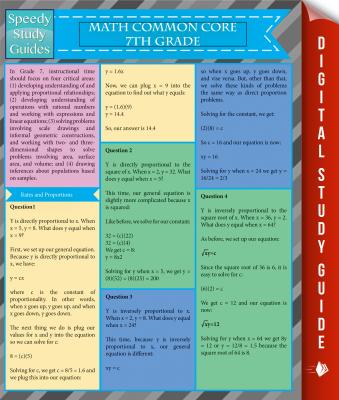ТОП просматриваемых книг сайта:
Math Common Core 7Th Grade (Speedy Study Guides). Speedy Publishing
Читать онлайн.Название Math Common Core 7Th Grade (Speedy Study Guides)
Год выпуска 0
isbn 9781633839762
Автор произведения Speedy Publishing
Жанр Математика
Издательство Ingram
In Grade 7, instructional time should focus on four critical areas: (1) developing understanding of and applying proportional relationships; (2) developing understanding of operations with rational numbers and working with expressions and linear equations; (3) solving problems involving scale drawings and informal geometric constructions, and working with two- and three- dimensional shapes to solve problems involving area, surface area, and volume; and (4) drawing inferences about populations based on samples.
Rates and Proportions
Question 1
Y is directly proportional to x. When x = 5, y = 8. What does y equal when x = 9?
First, we set up our general equation. Because y is directly proportional to x, we have:
y = cx
where c is the constant of proportionality. In other words, when x goes up, y goes up, and when x goes down, y goes down.
The next thing we do is plug our values for x and y into the equation so we can solve for c:
8 =(c)(5)
Solving for c, we get c = 8/5 = 1.6 and we plug this into our equation:
y = 1.6x
Now, we can plug x = 9 into the equation to find out what y equals:
y = (1.6)(9)
y = 14.4
So, our answer is 14.4
Question 2
Y is directly proportional to the square of x. When x = 2, y = 32. What does y equal when x = 5?
This time, our general equation is slightly more complicated because x is squared:
Like before, we solve for our constant:
32 = (c)(22)
32 = (c)(4)
We get c = 8:
y= 8x2
Solving for y when x = 5, we get y = (8)(52) = (8)(25) = 200
Question 3
Y is inversely proportional to x. When x = 2, y = 8. What does y equal when y = 24?
This time, because y is inversely proportional to x, our general equation is different:
xy = c
so when x goes up, y goes down, and vise versa. But, other than that, we solve these kinds of problems the same way as direct proportion problems.
Solving for the constant, we get:
(2)(8)= c
So c = 16 and our equation is now:
xy = 16
Solving for y when x = 24 we get y = 16/24 = 2/3
Question 4
Y is inversely proportional to the square root of x. When x = 36, y = 2. What does y equal when x = 64?
As before, we set up our equation:
Конец ознакомительного фрагмента.
Текст предоставлен ООО «ЛитРес».
Прочитайте эту книгу целиком, купив полную легальную версию на ЛитРес.
Безопасно оплатить книгу можно банковской картой Visa, MasterCard, Maestro, со счета мобильного телефона, с платежного терминала, в салоне МТС или Связной, через PayPal, WebMoney, Яндекс.Деньги, QIWI Кошелек, бонусными картами или другим удобным Вам способом.

